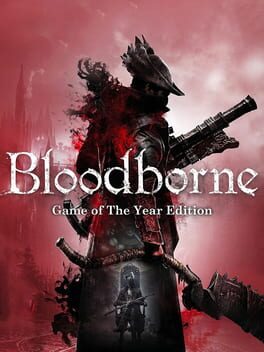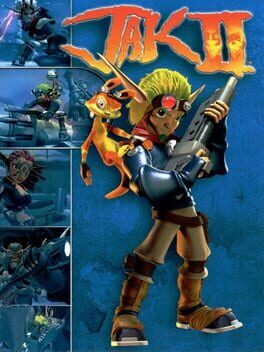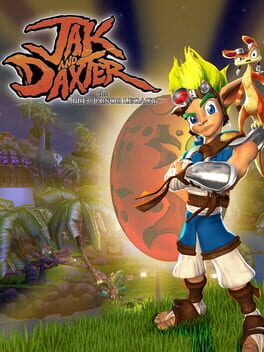Babylom
Bio
Nothing here!
Badges

3 Years of Service
Being part of the Backloggd community for 3 years
Favorite Games
023
Total Games Played
000
Played in 2024
000
Games Backloggd
Recently Reviewed See More
I respect the audacity and ambition of this game—and the flagrant assault on the sensibilities of the first game is a lot of fun. But overall, this game is incredibly poor. For every good mission (all of the races, and some of the platforming missions), there are four to five missions which are janky, gimmicky, and poorly designed. The race with Errol through the city is probably the high point of the game, but its clearly meant to be a pay-off for the many times you've been forced to backtrack through the city, and in that regards it really doesn't succeed in its intentions.
One of the biggest issues with the first game in the series is the way that it flits between multiple different gameplay styles, only some of which work, and most of which are uninteresting. When I play a turret mission or an escort mission in a game like this, I have to ask: Who is this for? When the game asks me to traipse back and forth between the same streets just so I can roll the dice on whether the next 'mission' will be a lazy whack-a-mole mini-game or a somewhat decent platforming level, there's a certain point at which I have no interest in continuing.
Look, I like challenge and I like hard games—I like nasty games. But Jak II is all frustration and no satisfaction. It's a conceptual mess which fuses multiple game styles together, but it opts for breadth instead of depth in refusing to make any of its game styles mechanically polished or conceptually interesting.
One of the biggest issues with the first game in the series is the way that it flits between multiple different gameplay styles, only some of which work, and most of which are uninteresting. When I play a turret mission or an escort mission in a game like this, I have to ask: Who is this for? When the game asks me to traipse back and forth between the same streets just so I can roll the dice on whether the next 'mission' will be a lazy whack-a-mole mini-game or a somewhat decent platforming level, there's a certain point at which I have no interest in continuing.
Look, I like challenge and I like hard games—I like nasty games. But Jak II is all frustration and no satisfaction. It's a conceptual mess which fuses multiple game styles together, but it opts for breadth instead of depth in refusing to make any of its game styles mechanically polished or conceptually interesting.
This review contains spoilers
I've long thought that it was all downhill for Naughty Dog after the original Crash Bandicoot.
Don't get me wrong, I think Cortex Strikes Back is an excellent game—but the original, with its puritanical stance towards platforming prowess and its coherent sense of journey is to me perhaps the finest 3D platformer of all time. Instead, the sequel fragments its world into locations accessible only via portals, and thus sacrifices the tangible sense of progression that the original has (I still get goosebumps climbing the side of Cortex' tower on the world map of the original). Despite this however, the sequel does have one extremely clear advantage over the original: its sense of mystery, and knack for hiding secrets. Although some of its secrets are more arbitrary than others, there are few games that reward a player's sense of exploration, in my opinion.
Unfortunately, even this is lost in the highly mediocre trilogy-closer Warped, which features a small cluster of platforming levels bulked out with a series of annoying vehicle sections. (And the less said about later Naughty Dog projects like the Uncharted quartet the better, in my opinion.)
Jak and Daxter, as Naughty Dog's second big project, both apes the strengths of the Crash Bandicoot trilogy whilst also replicating its failures. It has a coherent inter-connected world, but its open-ness combined with its threadbare plot mean that whilst it feels seamless and grounded, there is little sense of direction in the game—certainly nothing approaching Cortex' tower, which is ever-present in the background of Crash Bandicoot. Further, it takes the explorative aspect of Cortex Strikes Back's secrets and spins it into an entire game—sadly, though, much of the exploration revolves around finding new, and annoying, mini-games which then have to be played to acquire power cells (such as the fishing minigame).
Look, Jak and Daxter is a very fun game, but its mix of high-ambition when it comes to gameplay styles, and low-ambition when it comes to the depth of exploration, makes it very flawed. The best missions here are those that ask you to consider your environment and where within that environment a power cell may be hidden. The two best power cells do this brilliantly.
The first is in the spider cave. The entrance room of the level is full of centipedes burrowing into wooden columns; once you have all but one of the power cells in the level this room remains the only one which seems to lack a solid purpose. This leads the player to the conclusion that the power cell must involve this room, and thus the centipedes which do nothing and appear in no other room of the level. Since they hurt Jak, they must be enemies—and if they're enemies the player must be able to hurt them back. At this point the player realises that the power cell must come from exterminating them (and it does). It feels so rewarding to 'solve' this room, even if the actual task at hand isn't very compelling.
The second, and best, power cell in the game is hidden in the final hub world. In one of the levels in that hub world the player is told to break a crate hanging out of a wall using yellow eco in order to get a power cell—this is incredibly obvious in a visual sense and the pause menu gives the player this instruction openly. When I did this mission originally I thought it was pointlessly tacked on, given its simplicity—yet the true genius of this mission is that it teaches you that crates stuck in walls may contain power cells. And indeed, the final power cell in the final hub world is found in a crate hidden in a dark crevice of the mountain. However, that's not the end of it, because there's no yellow eco in the hub world to break open the crate. Instead, the player has to go into the spider cave (the closest level) and bring yellow eco back out into the hub world to break the crate. The best bit about this mission is that it really looks like Jak isn't able to get to the crate in time—but it is just barely possible.
To me, this is the true summation of the game's underlying theme of testing the possibilities of the world, of believing in one's ability to influence the game world. And yet it's such a startlingly good piece of level design that it also reveals the triviality of the vast majority of this game's sense of exploration. Most of this game consists of fairly linear levels in which all power cells will be obtained provided the player explores every, quite obvious, fork in the road. It's at this point that the open nature of the game feels more like a slightly abstracted linearity, devised solely to obscure how much the game holds the player's hand, than any meaningful sense of exploration. This tension between an aesthetic openness and a mechanical tunnel-vision is something that will come to define Naughty Dog's Uncharted quartet—but in this instance, it speaks to the lost potential of a truly explorative 3D platformer.
Don't get me wrong, I think Cortex Strikes Back is an excellent game—but the original, with its puritanical stance towards platforming prowess and its coherent sense of journey is to me perhaps the finest 3D platformer of all time. Instead, the sequel fragments its world into locations accessible only via portals, and thus sacrifices the tangible sense of progression that the original has (I still get goosebumps climbing the side of Cortex' tower on the world map of the original). Despite this however, the sequel does have one extremely clear advantage over the original: its sense of mystery, and knack for hiding secrets. Although some of its secrets are more arbitrary than others, there are few games that reward a player's sense of exploration, in my opinion.
Unfortunately, even this is lost in the highly mediocre trilogy-closer Warped, which features a small cluster of platforming levels bulked out with a series of annoying vehicle sections. (And the less said about later Naughty Dog projects like the Uncharted quartet the better, in my opinion.)
Jak and Daxter, as Naughty Dog's second big project, both apes the strengths of the Crash Bandicoot trilogy whilst also replicating its failures. It has a coherent inter-connected world, but its open-ness combined with its threadbare plot mean that whilst it feels seamless and grounded, there is little sense of direction in the game—certainly nothing approaching Cortex' tower, which is ever-present in the background of Crash Bandicoot. Further, it takes the explorative aspect of Cortex Strikes Back's secrets and spins it into an entire game—sadly, though, much of the exploration revolves around finding new, and annoying, mini-games which then have to be played to acquire power cells (such as the fishing minigame).
Look, Jak and Daxter is a very fun game, but its mix of high-ambition when it comes to gameplay styles, and low-ambition when it comes to the depth of exploration, makes it very flawed. The best missions here are those that ask you to consider your environment and where within that environment a power cell may be hidden. The two best power cells do this brilliantly.
The first is in the spider cave. The entrance room of the level is full of centipedes burrowing into wooden columns; once you have all but one of the power cells in the level this room remains the only one which seems to lack a solid purpose. This leads the player to the conclusion that the power cell must involve this room, and thus the centipedes which do nothing and appear in no other room of the level. Since they hurt Jak, they must be enemies—and if they're enemies the player must be able to hurt them back. At this point the player realises that the power cell must come from exterminating them (and it does). It feels so rewarding to 'solve' this room, even if the actual task at hand isn't very compelling.
The second, and best, power cell in the game is hidden in the final hub world. In one of the levels in that hub world the player is told to break a crate hanging out of a wall using yellow eco in order to get a power cell—this is incredibly obvious in a visual sense and the pause menu gives the player this instruction openly. When I did this mission originally I thought it was pointlessly tacked on, given its simplicity—yet the true genius of this mission is that it teaches you that crates stuck in walls may contain power cells. And indeed, the final power cell in the final hub world is found in a crate hidden in a dark crevice of the mountain. However, that's not the end of it, because there's no yellow eco in the hub world to break open the crate. Instead, the player has to go into the spider cave (the closest level) and bring yellow eco back out into the hub world to break the crate. The best bit about this mission is that it really looks like Jak isn't able to get to the crate in time—but it is just barely possible.
To me, this is the true summation of the game's underlying theme of testing the possibilities of the world, of believing in one's ability to influence the game world. And yet it's such a startlingly good piece of level design that it also reveals the triviality of the vast majority of this game's sense of exploration. Most of this game consists of fairly linear levels in which all power cells will be obtained provided the player explores every, quite obvious, fork in the road. It's at this point that the open nature of the game feels more like a slightly abstracted linearity, devised solely to obscure how much the game holds the player's hand, than any meaningful sense of exploration. This tension between an aesthetic openness and a mechanical tunnel-vision is something that will come to define Naughty Dog's Uncharted quartet—but in this instance, it speaks to the lost potential of a truly explorative 3D platformer.







